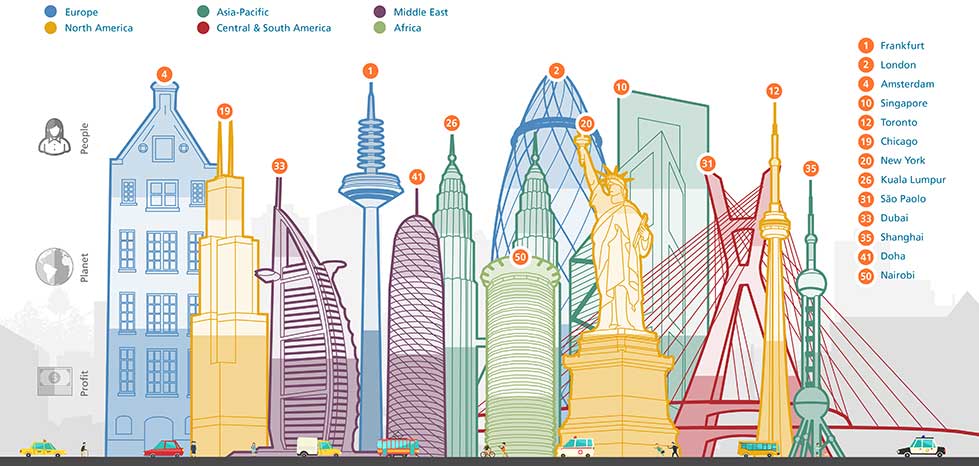
When we refer to sustainability or sustainability In ecology, we describe how biological systems "sustain" themselves diverse, serve us as resources, and are productive over time.
That is, we are talking about balance of a species with the resources of the environment. According to the 1987 Brundtland report referring to ourselves as a species, sustainability applies to exploitation of a resource by below the renewal limit natural of it.
Types of sustainability
Sustainability seeks a common ideal and that is why it is a socio-economic process.
That said, we can say that there are several types of sustainability.
Political sustainability
Redistribute the political and economic power, ensures that there are consistent rules in the country, that we have a safe government and establishes a legal framework guaranteeing respect for people and the environment.
It fosters solidarity relations between communities and regions thus improving the quality of life and reducing dependency on communities, thus generating democratic structures.
Economic sustainability
When we talk about this sustainability we refer to the ability to generate wealth in equitable amounts and suitable for the different social spheres, to establish poblaciones let them be totally capable and solvent of their own financial problems, which can by themselves increase production and strengthen consumption in sectors of monetary production.
For this reason, if sustainability is a balance, this type of sustainability is a balance between nature and man, a balance that seeks to satisfy current needs without sacrificing future generations.
Environmental sustainability
This type of sustainability is the most important (to be studied in our respective teaching fields) and object of "analysis" in this article.
It refers to nothing more nor less than the ability to maintain biological aspects in its productivity and diversity over time. In this way, the preservation of natural resources is achieved.
This sustainability encourages environmentally conscious responsibilities and it makes human development grow by caring for and respecting the environment where it lives.
Measurement of environmental sustainability
Sustainability measures are environmental or other types, they are quantitative measures in development phases to be able to formulate environmental management methods.
The 3 best measures today are the Environmental Sustainability Index, the Environmental Performance Index and the triple result.
Sustainability Index
This is a recent index and is an initiative of the Global Leaders for Tomorrow Environmental Task Force of the World Economic Forum.
The Environmental Sustainability Index or Environmental Sustainability Index, for short the ESI, is an indexed indicator, hierarchically structured, which comprises 67 variables of equal weighted weight in the total (in turn structured in 5 components, in turn consisting of 22 factors).
In this way, the ESI combines 22 environmental indicators ranging from air quality, waste reduction to protection of international commons.
The grade obtained by each country is broken down into 67 more specific subjects, such as the measurement of sulfur dioxide in urban air and deaths associated with poor sanitary conditions.
The ESI measures five central points:
- The state of the environmental systems of each country.
- The success obtained in the task of reducing the main problems in environmental systems.
- Progress in protecting its citizens from eventual environmental damage.
- The social and institutional capacity that each nation has to take actions related to the environment.
- Level of administration that each country has.
This is an index that as a meganumerary aggregation, aims to be "weighed" with GDP and the International Competitiveness Index (ICI), in order to complement substantive information, to better guide decision-making and the design and execution of policies.
The range of environmental variables included is extremely complete (concentrations and emissions of pollutants, quality and quantity of water, energy consumption and efficiency, exclusive areas for vehicles, use of agrochemicals, population growth, perception of corruption, environmental management, etc. ), although the authors themselves acknowledge that there are very interesting variables about which there is no information.
The information they shed the first results of this index seems to be consistent with what can be observed in reality, having best ESI value countries like Sweden, Canada, Denmark and New Zealand.
Environmental Performance Index
Known by the acronym EPI Environmental Performance Index is a method for quantify and classify numerically the environmental performance of a country's policies.
The variables that are taken into account for the calculation of the EPI are divided into 2 objectives: the vitality of ecosystems and environmental health.
Likewise, environmental health is divided into political categories, specifically 3 that are:
- The effects of air quality on health.
- Basic sanitation and drinking water.
- The impact of the environment on health.
And the environmental vitality is divided into 5 political categories also that are:
- Productive natural resources.
- Biodiversity and habitat.
- Water resources.
- Effects of air pollution on ecosystems.
- Climate change.
Together with all these categories and to obtain the result of the index, they are taken into account 25 indicators for your relevant evaluations (highlighted in the image below).

Triple result
The triple bottom line or the triple bottom line is nothing more than a term related to sustainable business, referring to the performance caused by a company expressed in three dimensions: social, economic and environmental.
Evidence of performance in relation to the triple result They are manifested in the sustainability or corporate social responsibility reports.
In addition, an organization with good performance In accounting terms, a triple bottom line would result in the maximization of its economic benefit and environmental responsibility, as well as the minimization or elimination of its negative externalities, emphasizing the social responsibility of the organization towards stakeholders, and not only towards shareholders.
Goals of environmental sustainability
Sustainability faces big problems in today's world and one of them is the need for bet definitively by The renewable energies how much we support in this blog.
And it is that the consumption of traditional energies supposes a environmental wear that will soon be irreversible.
It is for this reason that the first objective that sustainability has to achieve (and I mean the general one, not just the environmental one) is manage to create a global conscience.

We must understand that we exist in a interconnected planetThat what we do affects others and our good or bad decisions will affect our sons and daughters in the near future.
Little by little that awareness is taking shape as many very good initiatives are seen in various countries to promote adequate sustainability.
The closest case is that of the project Barcelona Smart City, which in the category of Barcelona + sustainable, has created a collaborative map where all the sustainable initiatives of the city are grouped. A more than interesting tool to keep track of all the initiatives that are being carried out.
Sustainability in your home
Can there be sustainability in your home?
Today there are more of us who are thinking of having a sustainable houseThey are great since it takes into account different factors, such as its orientation, the energy it uses (especially solar), the open spaces it includes and how it is insulated to avoid energy loss.
All of these improvements make it energy efficient and less polluting, and they are sustainability works that you can consider doing in the long term to contribute yourself to the health of the planet.
In fact, you can visit 2 articles about bioclimatic architecture quite interesting:
- Energy savings in homes. Bioclimatic architecture.
- Bioclimatic architecture. An example with my house.
Characteristics of sustainable cities
Living in a totally sustainable home is very rewarding, but if we think on a larger scale, what are the characteristics of sustainable cities?
Cities that are called sustainable must have the following characteristics:
Urban development and mobility systems.
Public spaces and green areas are respected; travel does not take long (tolerable congestion), and vehicles and people coexist harmoniously.
Public transportation is efficient, and private transportation slows its growth.
Comprehensive management of solid waste, water and sanitation.
Solid waste is collected, separated, properly stored and recycled to generate value for a significant percentage of it.
Wastewater is treated and recycled to natural water sources, which mitigates environmental degradation.
These water sources (coasts, lakes, rivers) are respected and have adequate sanitation levels for humans.
Urban rivers are actively integrated into the life of the city.
Preservation of environmental assets.
The coasts, lakes and mountains are protected and integrated into the urban development of the city, so they can be used for civic life and city development.
Energy efficiency mechanisms.
These cities implement new technologies or procedures to reduce electricity consumption. In addition, they point you to the use of renewable energy.
Residence plan for the impacts of climate change.
The vulnerable areas in which people settle to live are reduced rather than increased, since there is an alternative housing plan and it can be implemented.
Organized fiscal accounts and adequate connectivity.
There are clear and transparent accounts, internet penetration is increasing, the connection speed is adequate and people are migrating towards the digitization of public services.
Positive indexes of citizen security.
The inhabitants feel that they can coexist peacefully because the incidence of crime and organized crime is decreasing and tends to stabilize at low levels.
Citizen participation.
The community makes use of communication resources, such as mobile applications, to discuss how to solve problems to improve the city.
Civil society and the rest of the local actors are organized to be able to have a bearing on the daily action of the life of the city.
I leave you with this last image where you can check which are the most sustainable cities and which are the least.

